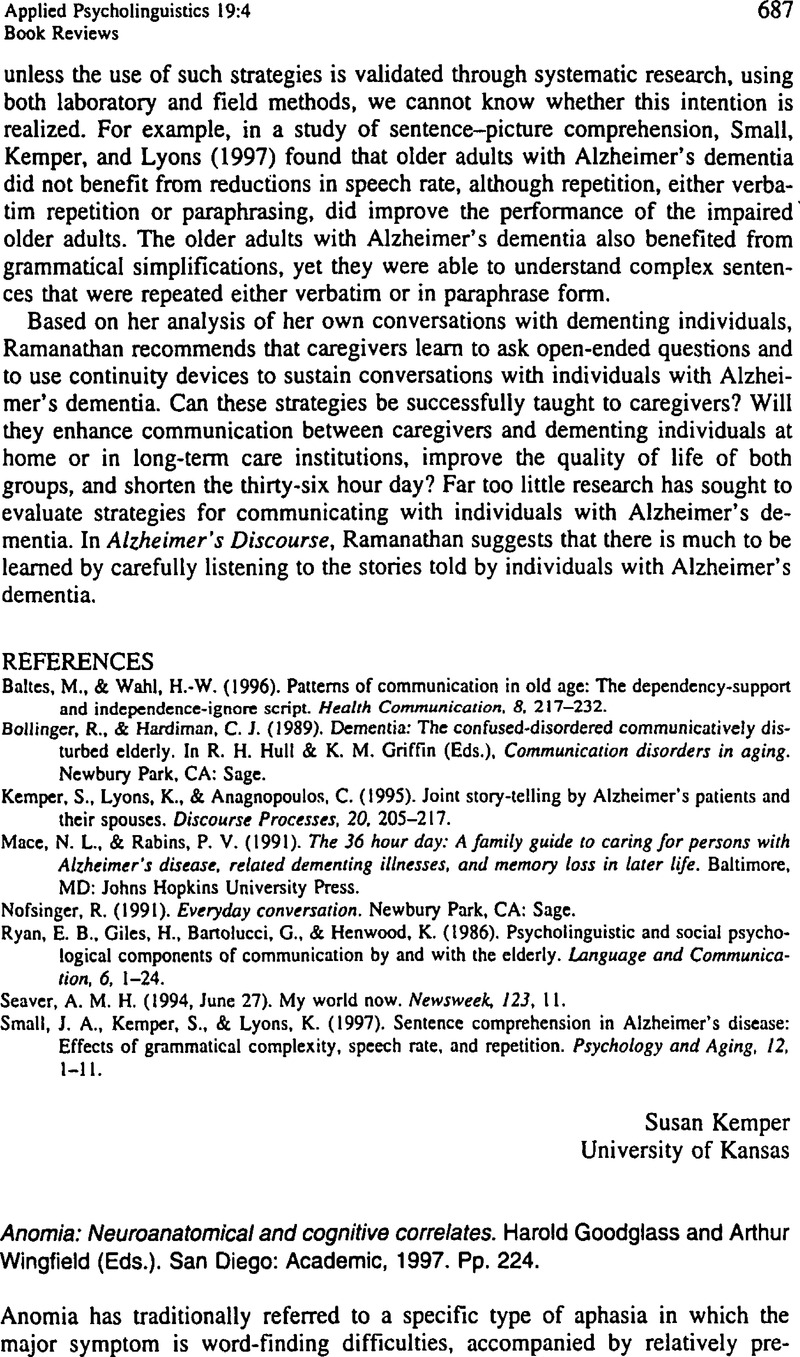No CrossRef data available.
Article contents
Anomia: Neuroanatomical and cognitive correlates. Harold Goodglass and Arthur Wingfield (Eds.). San Diego: Academic, 1997. Pp. 224.
Published online by Cambridge University Press: 28 November 2008
Abstract
An abstract is not available for this content so a preview has been provided. Please use the Get access link above for information on how to access this content.

- Type
- Book Reviews
- Information
- Copyright
- Copyright © Cambridge University Press 1998
References
Beauvois, M. F. (1982). Oplic aphasia. A process of interaction between vision and language. Philosophical Transactions of the Royal Society of London B, 298, 35–47.Google Scholar
Burke, D. M., MacKay, D. G., Worthley, J. S. & Wade, E. (1991). On the tip of the tongue: What causes word finding failure in young and older adults? Journal of Memory and Language, 30, 542–579.CrossRefGoogle Scholar
Dell, G. S., Schwartz, M. F., Martin, N., Saffran, E. M. & Gagon, D. A. (1997). Lexical access in aphasic and nonaphasic speakers. Psychological Review, 104, 801–838.Google Scholar
Farah, M. J. (1994). Neuropsychological inference with an interactive brain: A critique of the “locality” assumption. Behavioral and Brain Sciences, 17, 43–104.CrossRefGoogle Scholar
Farah, M. J. & McClelland, J. L. (1991). A computational model of semantic memory impairment: Modality-specificity and emergent category-specificity. Journal of Experimental Psychology: General, 120, 339–357.CrossRefGoogle ScholarPubMed
Geshwind, N. (1969). Problems in the anatomical understanding of the aphasis. In Benton, A. L. (Ed.), Contributions to clinical neuropsychology. Chicago: Aldine.Google Scholar
Goodglass, H., Kaplan, E., Weintraub, S. & Ackerman, N. (1976). The “tip-of-the-tongue” phenomenon in aphasia. Cortex, 12, 145–153.Google Scholar
Goodglass, H. & Stuss, D. T. (1979). Naming to confrontation versus oral description in three subgroups of aphasics. Cortex, 15, 199–211.CrossRefGoogle Scholar
Plaut, D. C, McClelland, J. L., Seidenberg, M. S. & Patterson, K. E. (1996). Understanding normal and impaired word reading: Computational principles in quasi-regular domains. Psychological Review, 103. 56–115.CrossRefGoogle ScholarPubMed
Semenza, C. & Zettin, M. (1989). Evidence from aphasia for proper names as pure referring expressions. Nature. 342, 678–679.CrossRefGoogle ScholarPubMed
Warrington, E. K. & Shallice, R. (1984). Category specific semantic impairments. Brain, 107, 829–854.CrossRefGoogle ScholarPubMed




